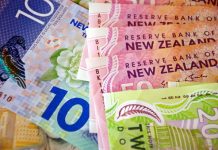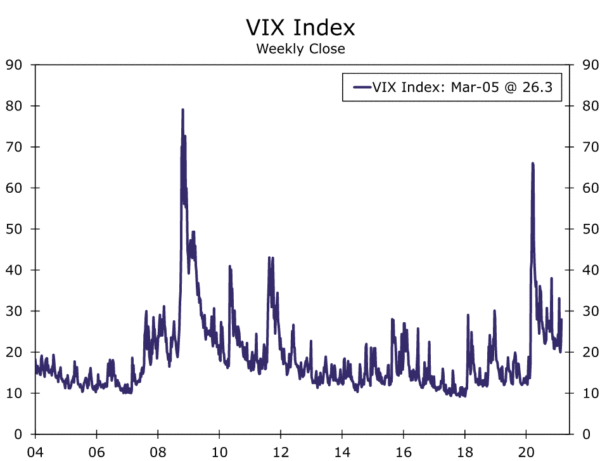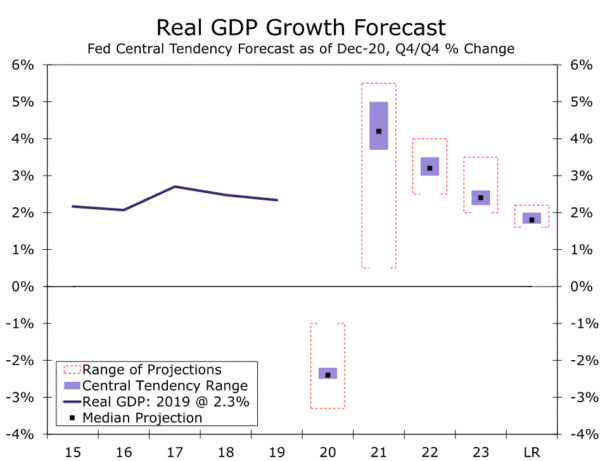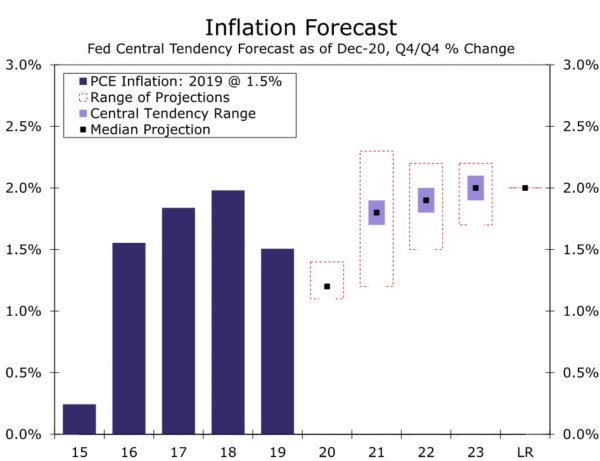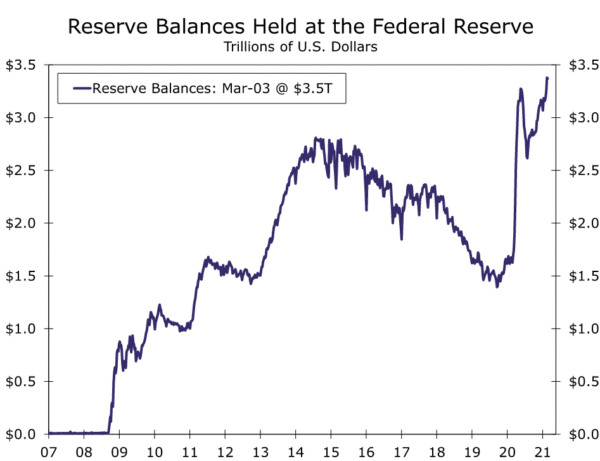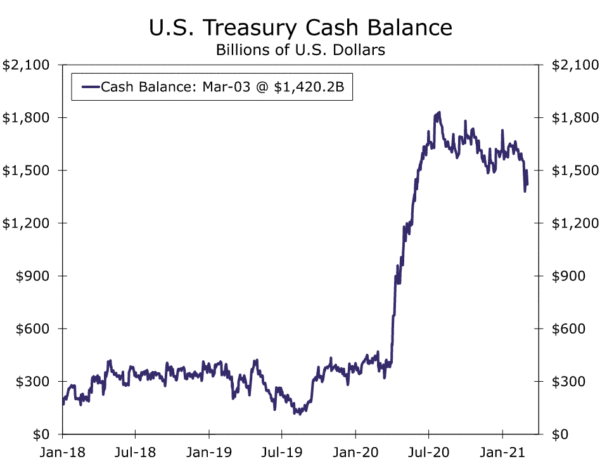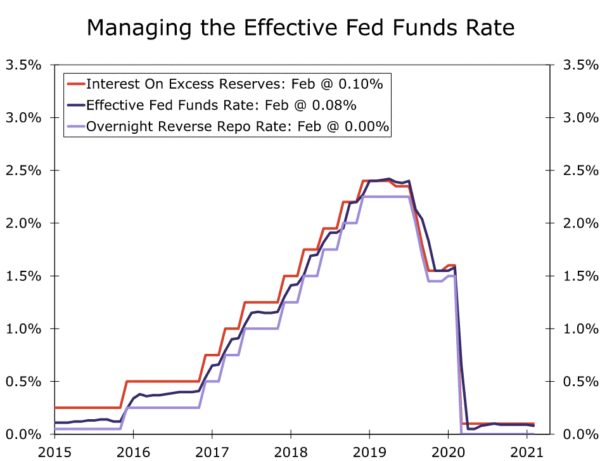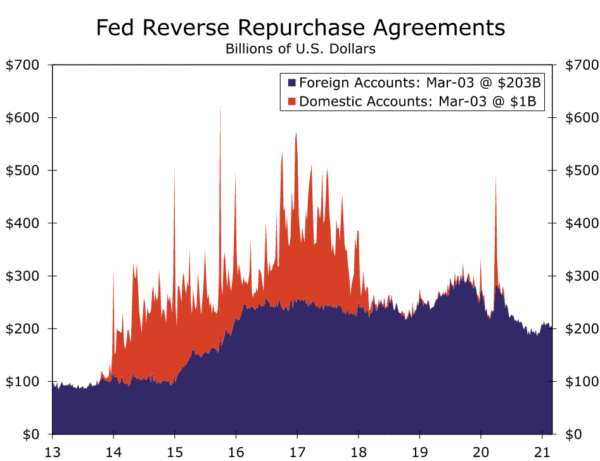Summary
We do not look for the FOMC to make any major monetary policy changes at its March 16-17 meeting. Moreover, we expect the Committee to clearly articulate that it has no intention of raising rates or otherwise removing policy accommodation anytime soon.
Prospects for the economy have brightened in light of recent sharp declines in new COVID cases and rising expectations for robust fiscal policy measures, which should boost economic growth. We expect the FOMC to acknowledge this brighter outlook for real GDP growth through its Summary of Economic Projections (SEP), which articulates the Committee’s macroeconomic forecasts. But, any upward adjustment that the Committee makes to its inflation forecast should be modest, because most Fed policymakers have signaled that they believe the pickup in inflation this year will prove to be temporary. The so-called “dot plot” may show that a committee member or two has shifted forward expectations for tightening policy, but we are skeptical that the bulk of the committee will be penciling in liftoff by 2023.
We also look for a technical adjustment or two to some operational procedures due to recent developments that have caused short-term interest rates to drift uncomfortably low. Specifically, we expect the FOMC to upwardly adjust the interest rate that the Federal Reserve pays on reserves that commercial banks hold at the central bank, so-called IOER. We also look for the Committee to bump up the Fed’s interest rate on its overnight reverse repo facility (ON RRP), and to boost the $30 billion per day counterparty limit for ON RRP operations. We stress, however, that any such moves would be technical adjustments. They should not be interpreted as a signal of an imminent removal of policy accommodation by the Federal Reserve.
The Ides of March: A Very Different Meeting Than Last Year
In the lead-up to the scheduled meeting of the Federal Open Market Committee (FOMC) in March 2020, financial markets were coming unglued as the country woke up to the reality of the threat posed by the pandemic. The Committee did not stand on ceremony or even wait for its scheduled meeting on March 17-18, 2020. In a surprise move on March 3, the FOMC cut its target range for the fed funds rate by 50 bps. Then on Sunday, March 15, the Committee slashed rates by another 100 bps, which took the target range all the way back to 0.00% to 0.25%, and it restarted its quantitative easing (QE) purchases of Treasury securities and mortgage-backed securities. The FOMC canceled its scheduled meeting on March 17-18, but it announced a broad set of programs on March 23 that were intended to restore liquidity to credit markets that had essentially locked up.
As we enter the blackout period for the FOMC meeting on March 16-17, 2021, the backdrop is remarkably different. Yes, financial markets are jittery with a recent sell-off in the bond market, while equity markets have posted some of the biggest one-day swings seen in months. But, this is a far cry from where we were last year, when the VIX was north of 80—the highest reading of the stock market’s implied volatility index since October 2008 (Figure 1). Today, the VIX index is below 30. In short, market participants were worried at this time last year that the bottom was about to fall out of the economy. The market concern today is that the economy is growing so fast that it will compel the FOMC to begin removing policy accommodation in the not-too-distant future.
The backdrop for this FOMC meeting is vastly different from last March.
In our view, it is more or less unfathomable to think that the FOMC will hike rates at its March meeting, and a reduction in the monthly pace of asset purchases (currently $80 billion of Treasury securities and $40 billion in mortgage-backed securities) is also not likely. Furthermore, we expect the Committee to signal that it has no intention of raising rates or otherwise removing policy accommodation anytime soon. Specifically, we expect the FOMC to continue to say in its statement that it “expects to maintain an accommodative stance of monetary policy” until “maximum employment” is achieved and inflation runs “moderately above 2% for some time.” As described in more detail in the next section, we look for the FOMC to reinforce these words with signals from its macroeconomic forecasts that are contained in its Summary of Economic Projections (SEP).
We expect the Committee to signal that it has no intention of raising rates or otherwise removing policy accommodation anytime soon.
Dots Speak Louder Than Words
Next week’s FOMC meeting will bring some clues into what the Committee is expecting out of the recovery via its updated GDP forecasts in the SEP (Figure 2). Since the FOMC last published estimates in mid-December, the amount of fiscal support that is being provided by Congress has increased significantly. Many FOMC members had anticipated at least some additional COVID relief toward the end of the year, which was delivered to the tune of nearly $900 billion by the Consolidated Appropriations Act in late December. Subsequently, the Biden administration has proposed another round of fiscal relief, and that proposal is currently making its way through Congress. Congress appears on track to pass a package worth close to $1.9 trillion within days of the FOMC meeting. The prospects for substantial changes to the Committee’s economic projections look likely as a result. Although, less clear are the potential changes to the FOMC’s expected path of the fed funds rate.
Specifically, we expect to see notable upward revisions to estimates for GDP growth this year. Our own forecast looks for Q4 over Q4 GDP growth of 6.1% in 2021, handily above the median estimate of 4.2% that the FOMC made in December, as more direct aid to households sets the stage for a boom in consumer spending. Inflation estimates are likely to rise as a result (Figure 3). We would expect the median projection for headline PCE to rise above 2% given recent increases in commodity prices, but estimates for the core index should also point to inflation moving back to target more quickly. 2021’s pace of GDP growth is unlikely to last, and thus far Fed officials have signaled that they believe the pickup in inflation this year will prove to be temporary. We expect that any increases in the FOMC’s core inflation estimates will be modest, and that any pickup in inflation over the next few years is likely to be orderly.
FOMC members have been tripping over themselves to stress that it will take more than the fastest growth in a generation and pickup in inflation to pull forward interest rate hikes. Payrolls remain 9.5 million below their pre-pandemic level and inflation has generally undershot 2% for years. Therefore, while the “dot plot” may show that a committee member or two has shifted forward expectations for tightening policy in 2023, we are skeptical that the bulk of the committee will be penciling in liftoff by then (Figure 4). The dot plot could be the clearest signal yet to the market that the FOMC is still in no rush to raise rates. For all its faults, the dot plot remains a key communication tool in the Fed’s arsenal. We suspect that officials would try to avoid bringing instability to the middle part of the Treasury curve at this juncture by signaling an earlier increase in the fed funds rate.
Long-Term Rates Rising, but Short-Term Rates Drifting Toward Zero
The jump in long-term Treasury yields has stolen the show over the past few weeks, but the FOMC may need to spend more time discussing short-term interest rates at its March meeting. In our previous FOMC Flashlight report, we highlighted a medium-term problem facing the Federal Reserve: Enormous cash holdings in the banking system are exerting downward pressure on short-term interest rates, including the central bank’s main policy rate, the fed funds rate. Note that this is the inverse of the problem that arose in money markets in September 2019, when short-term rates spiked due to upward pressure in funding markets.
At present, the Federal Reserve’s asset purchase program continues to remove securities and add bank reserves to the financial system (Figure 5), while at the same time the Treasury is slowly but surely reducing its operating cash balance at the central bank (Figure 6). The reduction in the Treasury’s cash balance has thus far been driven by reducing Treasury bills outstanding. As the Treasury has paid down some of this debt, some previous holders of Treasury bills now find themselves with cash and in search of some investment in which they can earn a positive rate of return. Going forward, we anticipate the Treasury’s cash balance will fall much faster after Congress passes a significant COVID relief package in the next couple of weeks. That is, we expect Treasury to finance some of the extra spending that Congress will appropriate by running down its enormous cash balances at the Fed. So even more cash will rain down on the financial system, which will put more downward pressure on short-term interest rates.
The Secured Overnight Financing Rate (SOFR), which is slated to replace LIBOR as the benchmark lending rate, fell to just 0.01% on February 23 and again on February 26. T-bill yields are barely positive at present, with one- and three-month T-bills yields just 0.03% and 0.04%, respectively. If Congress passes another large COVID relief package and the Federal Reserve continues its asset purchase program for the foreseeable future, then even more cash will be looking for a home in the coming months. This, in turn, could put downward pressure on short-term interest rates and potentially push them below 0%.
Policymakers at the Federal Reserve likely would prefer to avoid this outcome. Negative short-term interest rates can create problems in parts of the financial system, particularly money market funds. In addition, the fed funds rate could be dragged down alongside these other short-term rates. The fed funds rate has been 0.07% or 0.08% for the past several weeks, which is on the low side of the Fed’s 0.00%-0.25% target range (Figure 7). For now, an effective fed funds rate around those levels is probably high enough to stave off immediate action. That said, the Fed must consider whether preemptive action is warranted, given the avalanche of cash coming down the pipe.
So, what can the Federal Reserve do to nudge short-term interest rate higher? Critically, the Fed would be looking to bring rates just a bit higher for operational reasons, and not to tighten monetary policy. A 0.05 percentage point increase in IOER would help push short-term interest rates higher. At present, the Federal Reserve pays commercial banks an interest rate of 0.10% on the cash (i.e. reserves) they hold at the Federal Reserve. IOER helps put a soft “floor” on short-term interest rates, because commercial banks have little incentive to lend cash in the market at rates that are lower than what they can earn by simply parking cash at the Fed.
We look for the FOMC to tweak IOER a bit higher.
In addition to the IOER increase, we believe the FOMC might make some changes to its Overnight Reverse Repo (ON RRP) facility. The rate paid in the ON RRP facility acts as the secondary, firmer interest rate floor below IOER, because the facility is open to more than just commercial banks. Other financial entities, particularly money market funds, can take their cash to the Federal Reserve and park it in the ON RRP facility, where it currently earns 0%. As the Fed puts it “any counterparty that can use the ON RRP facility should be unwilling to invest funds overnight with another counterparty at a rate below the ON RRP rate, just as any depository institution eligible to earn interest on reserves should be unwilling to invest funds overnight with another counterparty at a rate below the interest rate on excess reserves.”
We believe the FOMC may make two changes here: It could increase the interest rate paid on ON RRP transactions, and it could increase the counterparty limit from the current $30 billion per counterparty per day. The former would be relatively straightforward as it should put upward pressure on short-term interest rates similar to an upward adjustment in IOER. For the latter, increasing the size per counterparty could help ensure that the facility has the capacity to handle inflows well above the all-time high of roughly $650 billion (Figure 8). By our count from the Federal Reserve Bank of New York’s website, there are 42 non-bank counterparties for the ON RRP facility, bringing the hypothetical maximum usage among these counterparties to about $1.3 trillion per day.
In “normal” times, this would probably be enough to soak up all the excess cash, but by our calculations, total bank reserves could increase by about $1.5 trillion between now and June 30. Some of these reserves will be absorbed by banks and thus can sit at the Fed earning IOER, but exactly how much is difficult to say. Furthermore, the $1.3 trillion estimate of maximum usage ignores that some counterparties are much bigger than others. So, while $30 billion might be more than enough for one counterparty, for a much larger entity it may not be big enough to handle all of their excess cash. Bumping up the counterparty limits seems prudent in our view, and would mirror the aggressively large repo offerings the Federal Reserve set on the lending side of repo market in March 2020.
Note that adjustments to IOER and the ON RPP facility are not mutually exclusive, and in fact, we think making them together makes the most sense. Furthermore, there are other permutations we have not discussed. Perhaps the FOMC could make a more dramatic change to IOER, such as boosting it back to the 0.25% rate that prevailed from December 2008 through December 2015. Or perhaps the Committee could engage in an “Operation Twist” where it sells shorter-dated securities and buys longer-dated ones, thus changing the mix of its Treasury holdings but keeping the overall size of its balance sheet unchanged. An “Operation Twist” would simultaneously put upward pressure on short-term interest rates, which are uncomfortably low at present, while putting downward pressure on longer-term rates, which have snapped higher in recent weeks.
At the moment, however, we view these moves as unlikely. A substantial increase to IOER or an “Operation Twist” could potentially be perceived among market participants as monetary tightening for the former and monetary easing for the latter. We think the FOMC is more or less satisfied with the current level of monetary policy accommodation and would want to keep these operational issues separate from monetary policy. As a result, we think more modest changes to IOER and ON RRP are in store.
It is important to stress that any tweaks that the Committee makes to IOER and ON RRP should be viewed as technical in nature. That is, the FOMC would be attempting to nudge up short-term rates, which have drifted uncomfortably low due to a surfeit of cash in the financial system. But these moves, should they occur at this FOMC meeting, should not be interpreted as a signal that the FOMC is getting ready to move the entire structure of rates higher via a reduction in the Fed’s monthly pace of asset purchases or in an increase in the target range for the fed funds rate.


